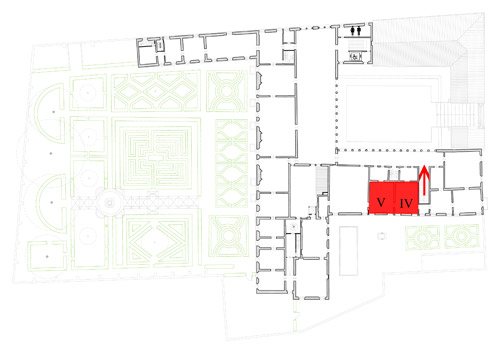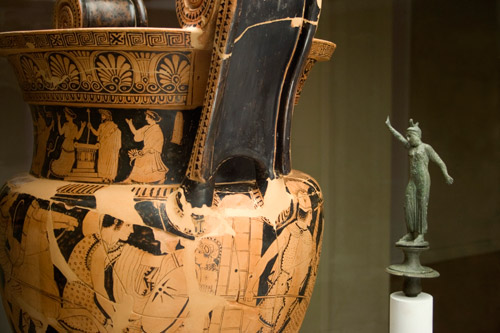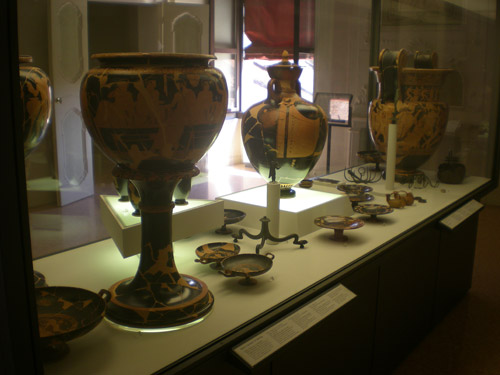
Room IV
To the end of the fifth century BC, the period of greatest prosperity of the city, are dated grave goods of even greater value. This is the case of grave 128 of the Valle Trebba, isolated and topped with a mound of pebbles and decorated with an engraved stele, probably referring to a member of the political elite who dominated the city, and a follower of the cult of Dionysus. The deceased, placed in a wooden chest, was accompanied by a fullbanquet set with containers, utensils and bronze decor of Etruscan production, togetherwith Attic pottery of great excellence.
Some bronze artifacts, produced in Vulci and dating from the early years of the fifth century BC, such as a candelabra, a branch tripod and a crater, with preserved foot and loops representing the Dioscuri, carved all.round, were included among the other objects as "family goods", likely a gift from people of high rank or war chest, treasured and passed on for years before being placed in the tomb, according to an recurrent custom in Spina.
Among the Attic pottery a prominent role belongs to two large figured craters, a calyx one with a scene of Amazonomachy painted in the manner of the Peleus Painter, and a volute one attributed to the school of Polygnotus representing the solemn procession in the presence of Dionysus- Sabazio and Rhea-Cybele, alluding to Orphic cults from the East in which, through purification rites, the soul can free itself from the prison of the body. A phallic stamnos, of probable ritual use both for its form and representations of Dionysian subject, a vessel, used in orgiastic rites, and possibly even as a infusion pot to propitiate the female fertility.
The presence of an iron blade and a bundle of thin iron rods, found broken, on the right of the deceased, have led scholars to advance various hypotheses. Interpretation of objects as banquet tools (knife and skewers), contrasts with the idea that the blade is part of a short sword, and that the metal rods, that X-rays have shown to be hollow inside and therefore difficult to use as skewers, are nothing but a lictor bundle. The sign of the supreme power typical for the magistrates is widespread in the Etruscan world, from the artifacts of the famous Tomb of Lictor Vetulonia of the seventh century BC to the representations on memorial stones of the fifth and fourth centuries BC.
Room V
The variety of imported items that, along with artifacts of local and Etruscan-padan production, were found in the richly equipped tombs, testify the role of Spina as a great emporium throughout the fifth and the first half of the fourth century BC. This is the period of the great vessels decorated by the best known artists of the protoclassical (Boreas Painter, Niobid Painter) and classical style (Polion, Polygnotus, Eretria Painter, Kleophon). The banquet, in its double value of funeral ritual and public or private celebration, is an event of great social importance that shows the wealth of the person who organizes it, and becomes a sort of ceremony in which the ideological values of the ruling class are expressed. For this reason, its representation is a central theme in the tomb contexts, a real "staging" to display the rank of the deceased, with references involving both funerary objects and the depicted scenes.

A social environment of great opulence is that manifested by the burial 11C of Valle Pega, marked by a marble stone. Among the funeral goods is a striking black-figure Panathenaic amphora, attributed to the Berlin Painter (480-470 BC), the only one of its kind found in Spina. Filled with oil, these particular vessels were given out as prizes to the winners of the sports games during the Panathenaic festivals in Athens. Older than the other items of the tomb (about 425 BC), it was probably considered a "family good”.
Scenes from the Athenian aristocracy lifestyle, made of banquets, gymnastics and gynaeceum are painted by great masters like Polygnotus and Kleophon on deinoi, high spherical wine vessels, while on other ceramics there are intense representations of ancient heroic myths related to the birth and development of the polis. This subject is suggested by the theme of Amazonomachy, the victorious battle of the Greeks against the legendary people of the Amazons, painted by the Niobid Painter on a massive volute krater dating to the middle of the fifth century BC.

Next room